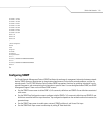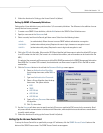
Switch Administration 7-19
set default s1 w allow
set default s1 s2 allow
set default s1 s3 allow
set default s2 w allow
set default s2 s1 allow
set default s2 s3 allow
set default s3 w allow
set default s3 s1 allow
set default s3 s2 allow
delete s1 all
delete s2 all
delete s3 all
/
// Router configuration
network
router
set type off
set dir both
set auth none
set enc-passwd 8e57
set id 1 1
set enc-key 1 e2565fc57c2a766fb0d55160d6f92952
set id 2 1
set enc-key 2 e2565fc57c2a766fb0d55160d6f92952
delete all
/
save
Configuring SNMP
The Simple Network Management Protocol (SNMP) facilitates the exchange of management information between network
devices. SNMP allows an administrator to manage network performance, find and solve network problems, and plan for
network growth. The WS 2000 Wireless Switch includes SNMP management functions for gathering information from its
network components, and communicating that information to specific users. For more background about SNMP, see SNMP
Management Support. There are four different SNMP screens.
• Use the SNMP Access screen to define SNMP v1/v2c community definitions and SNMP v3 user definitions associated
with access.
• Use the SNMP Trap Configuration screen to configure to define SNMP v1/v2c community definitions and SNMP v3 user
definitions associated with the traps themselves. Trap configuration depends on the network machine that receives the
generated traps.
• Use the SNMP Traps screen to enable system, network, SNMP, mobile unit, and Access Port traps.
• Use the SNMP Rate Traps screen to enable traps by setting RF Rate thresholds.


















